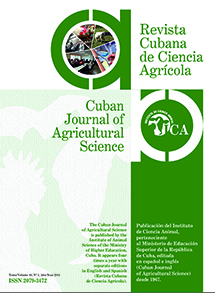Analysis of factors influencing productivity of two dairy farms in Sancti Spíritus, Cuba
Contenido principal del artículo
Resumen
The study was carried out in two dairy farms of Dos Ríos enterprise, during 2015 and 2016, in order to identify the main factors that influence dairy production. In the analysis, ten variables with the highest preponderance were identified, grouped into four principal components (PC), which explained 79.6 % of the variance. As a result of cluster analysis, four groups were f ormed, which respond, in a general sense, to each dairy farm at every season. Impact factors of each combination, principal
component vs. group, were identified. The production (PC1) in dry period showed values of -0.257 and -0.815, for farms 16 and 17, respectively, related to the high stocking rate and low proportion of biomass bank in dairy 17. Herd (PC2) showed a negative impact on farm 16, due to the low number of animals that it uses with respect to dairy 17. Reproduction (PC3) presented a negative impact in both units, which was very similar during rainy season. This phenomenon indicates a greater number of births in dry season, which is not suitable in tropical exploitation systems based on pastures and forages. Milk quality (PC4) showed negative
values in farm 16 during rainy season, due to mastitis. The results allowed to assess the factors with the greatest impact, average by groups and PC, and made it possible to identify, with certainty, the difficulties in the production system, so that strategies could be implemented to minimize or eliminate them.
Keywords: forage balance, impact, intake, pasture
component vs. group, were identified. The production (PC1) in dry period showed values of -0.257 and -0.815, for farms 16 and 17, respectively, related to the high stocking rate and low proportion of biomass bank in dairy 17. Herd (PC2) showed a negative impact on farm 16, due to the low number of animals that it uses with respect to dairy 17. Reproduction (PC3) presented a negative impact in both units, which was very similar during rainy season. This phenomenon indicates a greater number of births in dry season, which is not suitable in tropical exploitation systems based on pastures and forages. Milk quality (PC4) showed negative
values in farm 16 during rainy season, due to mastitis. The results allowed to assess the factors with the greatest impact, average by groups and PC, and made it possible to identify, with certainty, the difficulties in the production system, so that strategies could be implemented to minimize or eliminate them.
Keywords: forage balance, impact, intake, pasture
Detalles del artículo
Cómo citar
Reyes, J., Torres, V., March, J. M., & Hernández, Y. (2020). Analysis of factors influencing productivity of two dairy farms in Sancti Spíritus, Cuba. Cuban Journal of Agricultural Science, 54(4). Recuperado a partir de https://mail.cjascience.com/index.php/CJAS/article/view/991
Sección
Ciencia Animal
Aquellos autores/as que tengan publicaciones con esta revista, aceptan los términos siguientes:
- Los autores/as conservarán sus derechos de autor y garantizarán a la revista el derecho de primera publicación de su obra, el cuál estará simultáneamente sujeto a la Licencia Creative Commons Attribution-NonCommercial 4.0 International (CC BY-NC 4.0) que permite a terceros compartir la obra siempre que se indique su autor y su primera publicación esta revista. Bajo esta licencia el autor será libre de:
- Compartir — copiar y redistribuir el material en cualquier medio o formato
- Adaptar — remezclar, transformar y crear a partir del material
- El licenciador no puede revocar estas libertades mientras cumpla con los términos de la licencia
Bajo las siguientes condiciones:
- Reconocimiento — Debe reconocer adecuadamente la autoría, proporcionar un enlace a la licencia e indicar si se han realizado cambios. Puede hacerlo de cualquier manera razonable, pero no de una manera que sugiera que tiene el apoyo del licenciador o lo recibe por el uso que hace.
- NoComercial — No puede utilizar el material para una finalidad comercial.
- No hay restricciones adicionales — No puede aplicar términos legales o medidas tecnológicas que legalmente restrinjan realizar aquello que la licencia permite.
- Los autores/as podrán adoptar otros acuerdos de licencia no exclusiva de distribución de la versión de la obra publicada (p. ej.: depositarla en un archivo telemático institucional o publicarla en un volumen monográfico) siempre que se indique la publicación inicial en esta revista.
- Se permite y recomienda a los autores/as difundir su obra a través de Internet (p. ej.: en archivos telemáticos institucionales o en su página web) antes y durante el proceso de envío, lo cual puede producir intercambios interesantes y aumentar las citas de la obra publicada. (Véase El efecto del acceso abierto).
